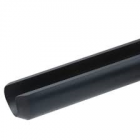In the AAW books Lathes and Turning Tools and Getting Started in Woodturning several authors promote that roughing gouges should be called spindle roughing gouges to warn turners not to use these gouges when turning bowls. While I sympathise with the intention, it has too narrow a focus.
Most of the roughing gouges made by forging a flat piece of HSS are rendered unsafe for bowl turning by having a narrow and shallow tang. They are also unsafe for spindle turning. I have broken two, and my staff have broken two P&N roughing gouges which have much stronger tangs. I conclude that most roughing gouges are not fit for purpose, and that changing the name merely accepts that we should be grateful for being sold unsafe tools.
Another factor is that roughing gouges are expensive. If excessively stressed, it should be the handle (which can be readily replaced) which breaks, not the tang.
Most of the roughing gouges made by forging a flat piece of HSS are rendered unsafe for bowl turning by having a narrow and shallow tang. They are also unsafe for spindle turning. I have broken two, and my staff have broken two P&N roughing gouges which have much stronger tangs. I conclude that most roughing gouges are not fit for purpose, and that changing the name merely accepts that we should be grateful for being sold unsafe tools.
Another factor is that roughing gouges are expensive. If excessively stressed, it should be the handle (which can be readily replaced) which breaks, not the tang.



